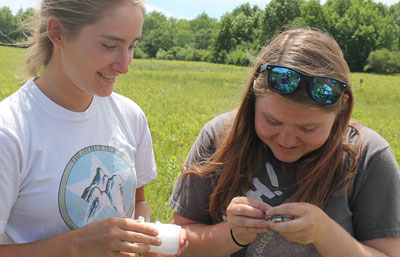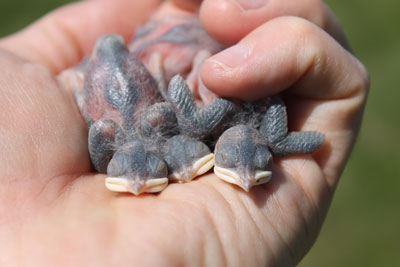July 1, 2015
By Elaine Jeon ’17

Elizabeth Black ’16 and Victoria Luizzi ’17, collecting data
Rain or shine, four dedicated biologists Elizabeth Black ’16, Joely DeSimone ’15, Victoria Luizzi ’17 and Natalie Sun ’18 have been spending seven days a week in the College’s Wildlife Sanctuary this summer collecting data on the effects blood-sucking fly larvae have on the growth and health of tree swallow nestlings.
The students and alumna are collaborating with Professor of Biology and Environmental Studies Ethan Clotfelter, who started studying tree swallows in 1998. He worked with those particular birds in the Wildlife Sanctuary from 2004 to 2009, and again in 2014 when DeSimone joined his lab for her honors thesis.
DeSimone, who graduated this past May, is working as a research assistant for Clotfelter this summer. Black is continuing DeSimone’s research for her own senior thesis, and Luizzi and Sun are both a part of the Science Undergraduate Research Fellows (SURF) program, which enables participants to immerse themselves in a hands-on, collaborative science research project for 8 to 10 weeks during the summer.
For her thesis, DeSimone found that while nestlings living in fly-infested nests lost more blood than their unparasitized counterparts, the two sets of birds were surprisingly similar in body size. This fact is likely due to the nestlings’ parents adjusting their feeding behaviors, according to DeSimone. Building on this work, Black plans to home in on how parent birds increase their feeding rates to compensate for the parasitized nests, and how this behavior could differ among parents based on their long-term prospects for survival.
“We collect data on parent bird body condition, feeding frequency, fledgling success rates and a few other proxies,” Black explained. “It’s a bit labor intensive. But we spend our days walking around in the bird sanctuary rather than bent over microscopes indoors, so I don’t really mind it.”
The schedule of data collection is heavily dependent on the tree swallows and when they leave their nests. As a result, the team has been observing the birds every single day to have the largest and most consistent data set possible.
“We end when the last nestlings leave their nest, which will be sometime in early July,” DeSimone said. “We’re able to do most everything in the field, even some of the blood analysis.”
“Later in the summer, when the birds start packing up and heading south, we’ll have more time to do more background research and process our data,” Black added.
Fieldwork: “It Keeps You Thinking and on Your Feet”
Choosing to work outside of a traditional lab setting has its difficulties, as there are many variables to account for. But Clotfelter said that the quality of the data he and his team are able to gather in the field makes that unpredictability worthwhile.

Tree swallow nestlings are monitored for the project
“In our work, students are able to follow the birds’ entire reproductive process, from nest building to egg laying to egg hatching to chick growth,” he explained. “And the students feel a sense of attachment and pride when ‘their’ babies leave the nest. We monitor nearly 100 nests and after a few weeks, the students learn the personalities of each pair of birds: some are great parents while others are lazy slackers.”
The researchers raved that they are finding this summer’s field research to be particularly intriguing.
“Instead of creating a perfect setting in which the researchers play God and can manipulate and control most of their variables, field research works with constantly changing variables,” Sun explained. “ It is challenging, of course, to work with these unpredictable factors, but fun as well. It keeps you thinking and on your feet and you never really know what to expect out there.”
“Even if you’re experimentally manipulating conditions in the field, the birds are still mostly living their normal lives, and we get to watch that happen,” Luizzi added. “It’s wonderful to be in the thick of things like that.”
Clotfelter echoed that passion for working in the field with students and described another charm of working outside: “Every day, there are surprises. Just last week, my students were huffed at by a deer, heard the howls of coyote pups and were chased simultaneously by bees and angry tree swallows.”